As the amount of data has grown exponentially with the advent of artificial intelligence and the Internet of Things, computing systems with high energy efficiency, high scalability, and high processing speed are urgently required. Unlike traditional digital computing, which suffers from the von Neumann bottleneck, brain-inspired computing can provide efficient, parallel, and low-power computation based on analog changes in synaptic connections between neurons. Synapse nodes in brain-inspired computing have been typically implemented with dozens of silicon transistors, which is an energy-intensive and non-scalable approach. Ion-movement-based synaptic devices for brain-inspired computing have attracted increasing attention for mimicking the performance of the biological synapse in the human brain due to their low area and low energy costs.
- ion movement
- synaptic device
- brain-inspired computing
1. Introduction
2. Biological Synapses
2.1. Properties of Biological Synapses
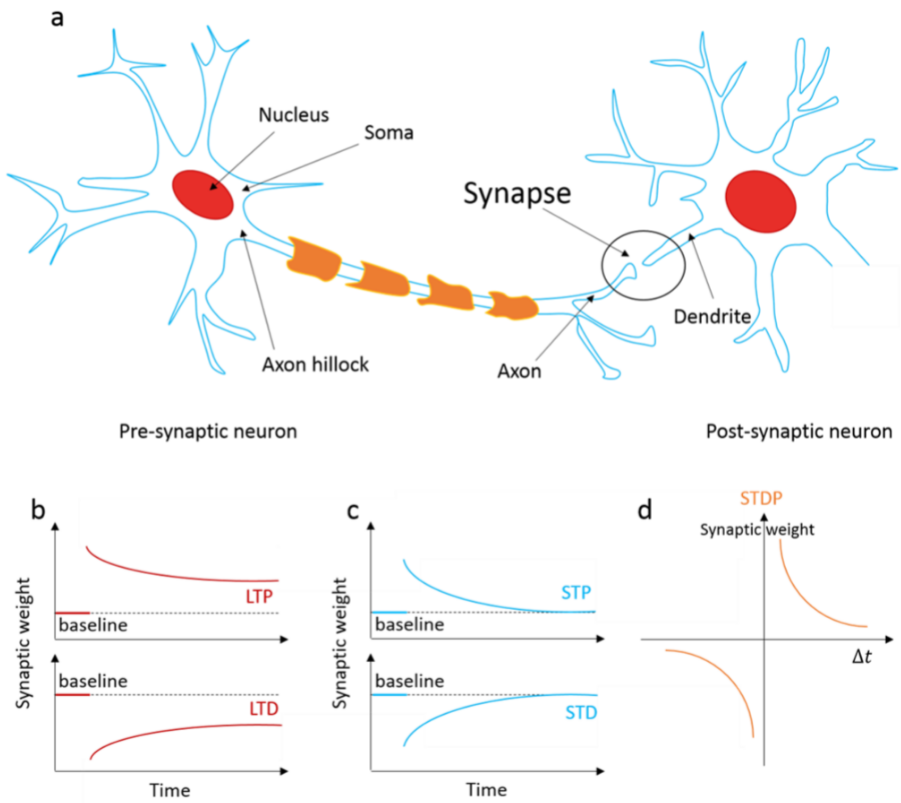
2.2. Biological Synaptic Plasticity
3. Synaptic Devices
3.1. Cation-Movement-Based Filamentary Two-Terminal Synaptic Devices
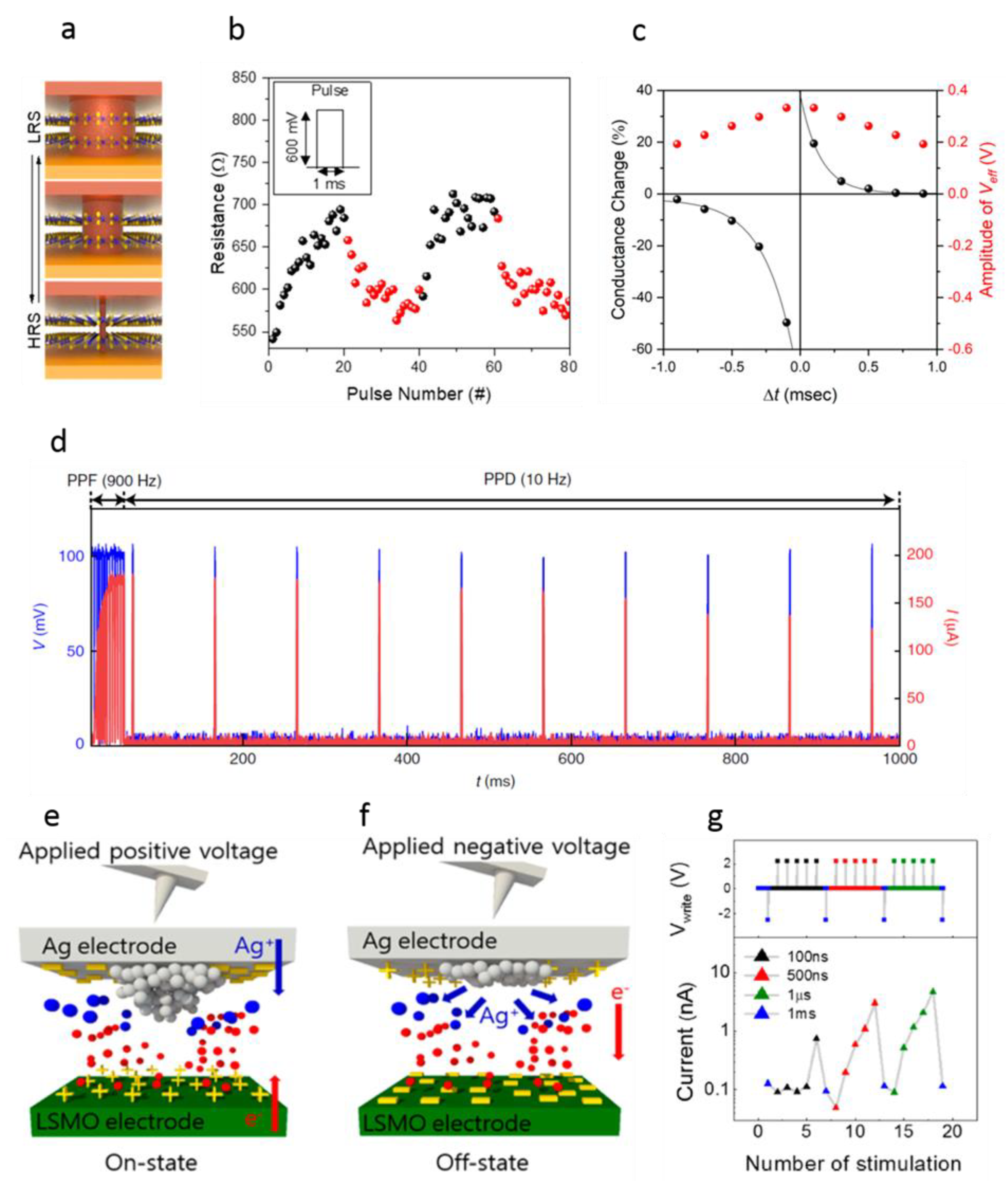
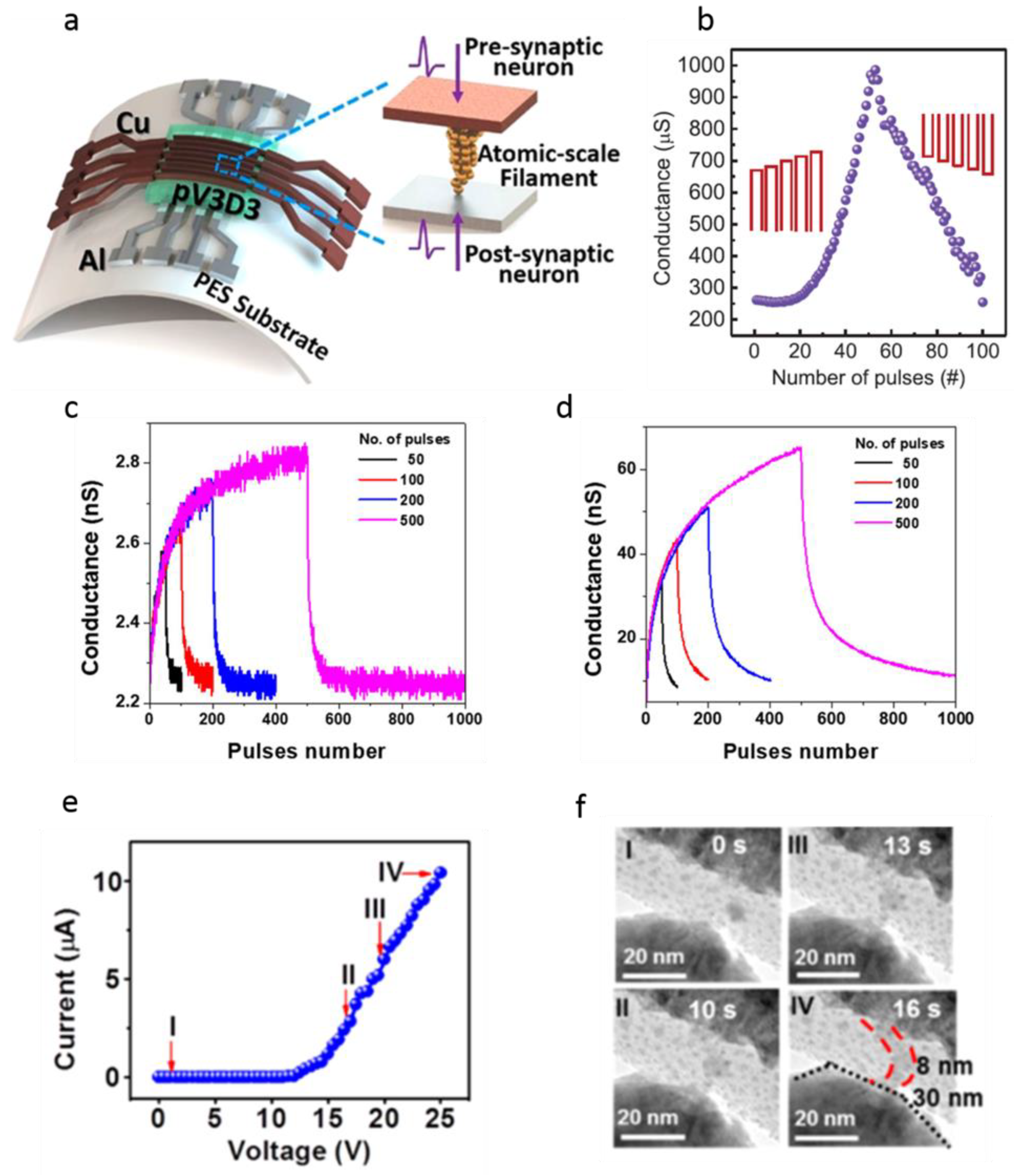
3.2. Anion-Movement-Based Filamentary Two-Terminal Synaptic Devices
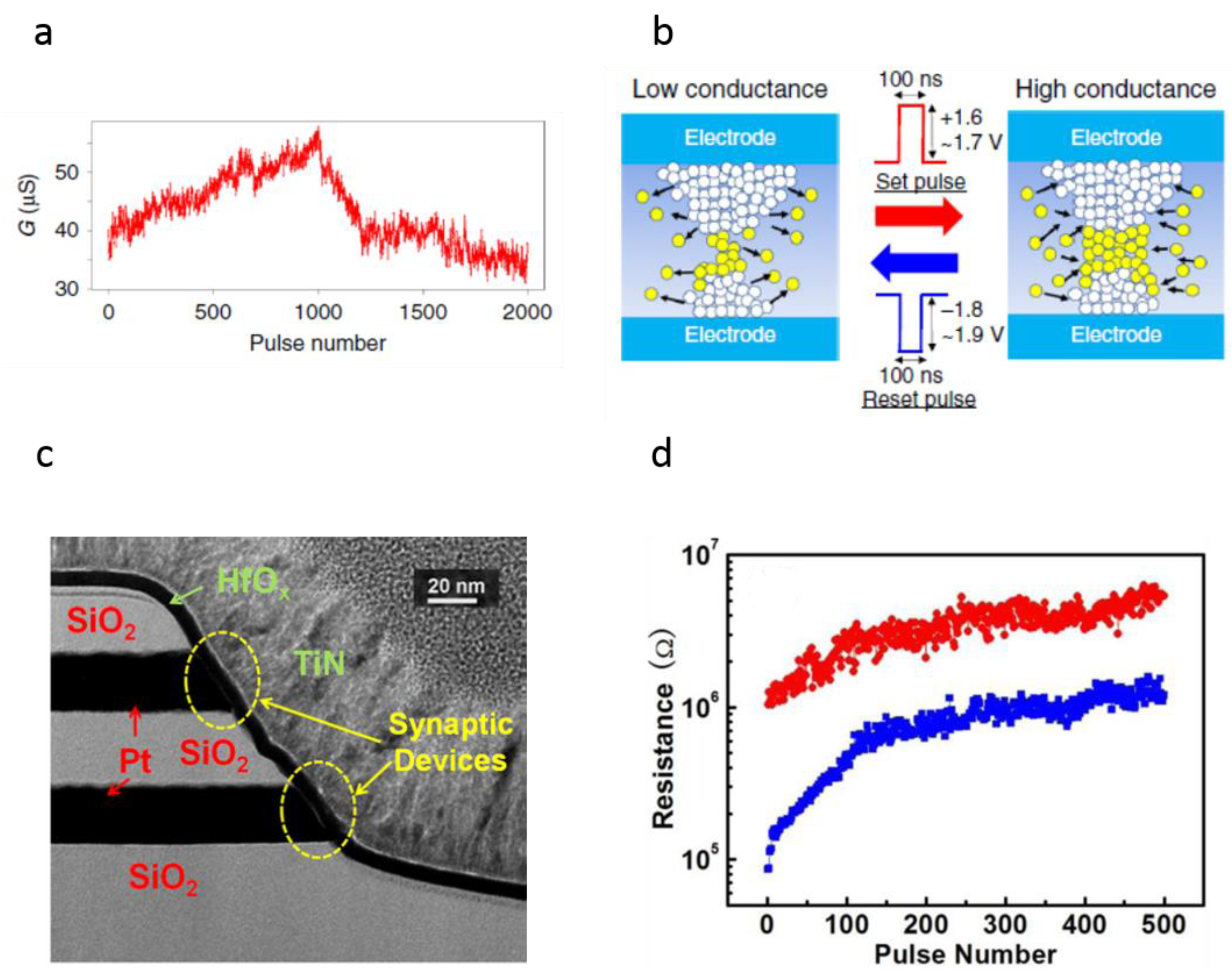
3.3. Cation-Movement-Based Ferroelectric Two-Terminal Synaptic Devices
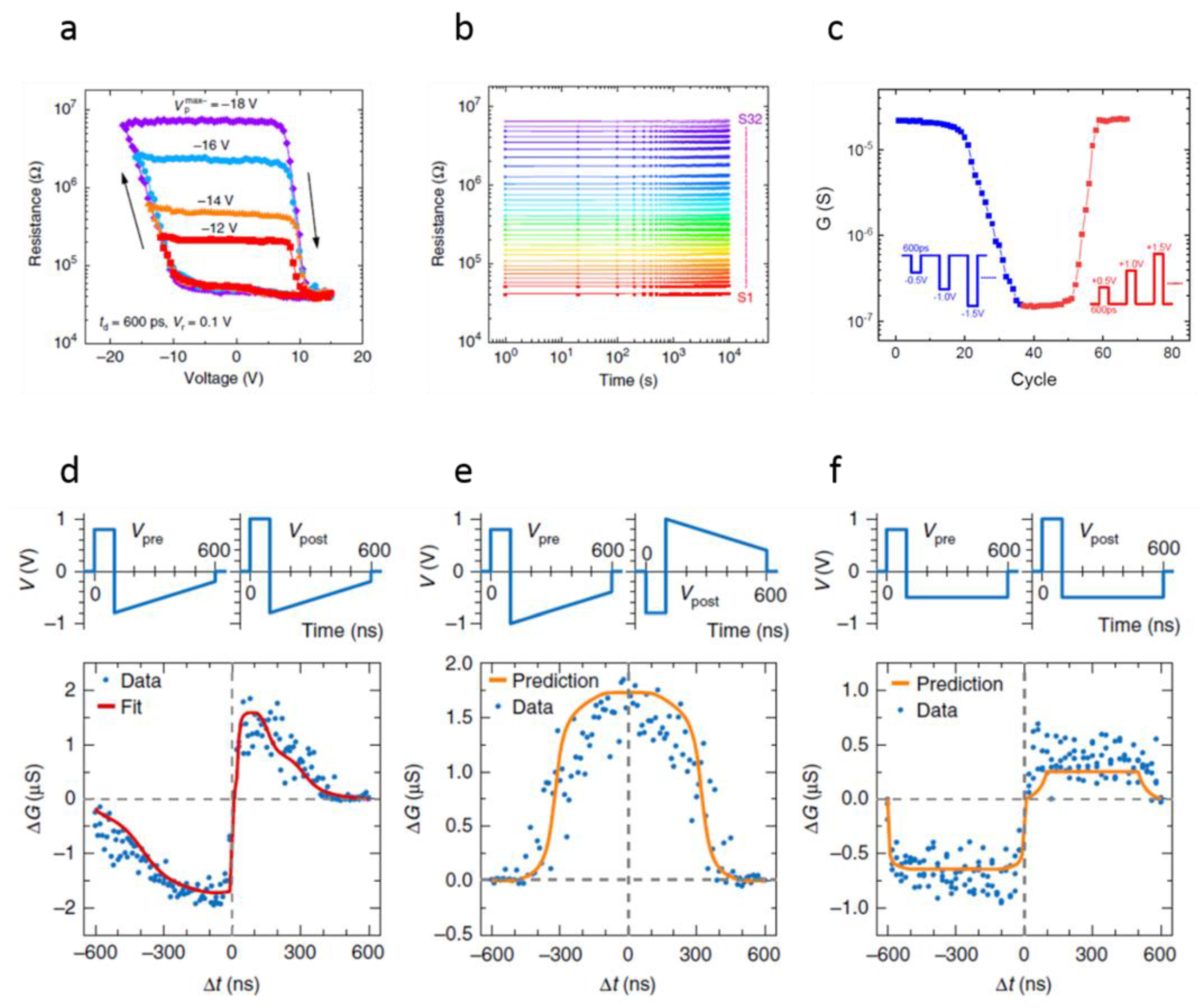
This entry is adapted from the peer-reviewed paper 10.3390/nano12101728
References
- Atzori, L.; Iera, A.; Morabito, G. The internet of things: A survey. Comput. Netw. 2010, 54, 2787–2805.
- Zanella, A.; Bui, N.; Castellani, A.; Vangelista, L.; Zorzi, M. Internet of things for smart cities. IEEE Internet Things J. 2014, 1, 22–32.
- Gubbi, J.; Buyya, R.; Marusic, S.; Palaniswami, M. Internet of things (IoT): A vision, architectural elements, and future directions. Future Gener. Comput. Syst. 2013, 29, 1645–1660.
- Hu, M.; Graves, C.E.; Li, C.; Li, Y.; Ge, N.; Montgomery, E.; Davila, N.; Jiang, H.; Williams, R.S.; Yang, J.J.; et al. Memristor-based analog computation and neural network classification with a dot product engine. Adv. Mater. 2018, 30, 1705914.
- Park, H.L.; Lee, Y.; Kim, N.; Seo, D.G.; Go, G.T.; Lee, T.W. Flexible Neuromorphic Electronics for Computing, Soft Robotics, and Neuroprosthetics. Adv. Mater. 2020, 32, 1903558.
- Xu, M.; Mai, X.; Lin, J.; Zhang, W.; Li, Y.; He, Y.; Tong, H.; Hou, X.; Zhou, P.; Miao, X. Recent Advances on Neuromorphic Devices Based on Chalcogenide Phase-Change Materials. Adv. Funct. Mater. 2020, 30, 2003419.
- Silver, D.; Schrittwieser, J.; Simonyan, K.; Antonoglou, I.; Huang, A.; Guez, A.; Hubert, T.; Baker, L.; Lai, M.; Bolton, A.; et al. Mastering the game of Go without human knowledge. Nature 2017, 550, 354.
- Ferrucci, D.; Brown, E.; Chu-Carroll, J.; Fan, J.; Gondek, D.; Kalyanpur, A.A.; Lally, A.; Murdock, J.W.; Nyberg, E.; Prager, J. Building Watson: An overview of the DeepQA progect. AI Mag. 2010, 31, 59–79.
- Rachlin, H. Making IBM’s computer, Watson, human. Behav. Anal. 2012, 35, 1–16.
- Kuzum, D.; Yu, S.; Wong, H.P. Synaptic electronics: Materials, devices and applications. Nanotechnology 2013, 24, 382001.
- Jeong, D.S.; Kim, K.M.; Kim, S.; Choi, B.J.; Hwang, C.S. Memristors for Energy-Efficient New Computing Paradigms. Adv. Electron. Mater. 2016, 2, 1600090.
- Sangwan, V.K.; Hersam, M.C. Neuromorphic nanoelectronic materials. Nat. Nanotechnol. 2020, 15, 517–528.
- Zokopoulos, P.C.; Eaton, C.; Deroos, D.; Deutsch, T.; Lapis, G. Understanding Big Data: Analytics for Enterprise Class Hadoop and Streaming Data; McGraw-Hill: New York, NY, USA, 2012.
- Upadhyay, N.K.; Jiang, H.; Wang, Z.; Asapu, S.; Xia, Q.; Yang, J.J. Emerging Memory Devices for Neuromorphic Computing. Adv. Mat. Technol. 2019, 4, 1800589.
- Goodfellow, I.; Bengio, Y.; Courville, A. Deep Learning; The MIT Press: Cambridge, MA, USA, 2016.
- LeCun, Y.; Bengio, Y.; Hinton, G. Deep learning. Nature 2015, 521, 436–444.
- Sengupta, B.; Stemmler, M.B. Power consumption during neuronal computation. Proc. IEEE 2014, 102, 738–750.
- James, C.D.; Aimone, J.B.; Miner, N.E.; Vineyard, C.M.; Rothganger, F.H.; Carlson, K.D.; Mulder, S.A.; Draelos, T.J.; Faust, A.; Marinella, M.J.; et al. A historical survey of algorithms and hardware architectures for neural-inspired and neuromorphic computing applications. Biol. Insp. Cog. Arch. 2017, 19, 49–64.
- Schuman, C.D.; Potok, T.E.; Patton, R.M.; Birdwell, J.D.; Dean, M.E.; Rose, G.S.; Plank, J.S. A survey of neuromorphic computing and neural networks in hardware. arXiv 2017, arXiv:1705.06963.
- Bear, M.F.; Connors, B.W.; Paradiso, M.A. Neuroscience: Exploring the Brain; Wolters Kluwer Health: Philadelphia, PA, USA, 2015.
- Indiveri, G.; Chicca, E.; Douglas, R.J. Artificial Cognitive systems: From VLSI networks of spiking neurons to neuromorphic cognition. Cogn. Comput. 2009, 1, 119–127.
- Indiveri, G.; Linares-Barranco, B.; Hamilton, T.J.; Schaik, A.; Etienne-Cummings, R.; Delbruck, T.; Liu, S.C.; Dudek, P.; Häfliger, P.; Renaud, S.; et al. Neuromorphic silicon neuron circuit. Front. Neurosci. 2011, 5, 73.
- Bezrukov, S.M.; Kish, L.B. Deterministic multivalued logic scheme for information processing and routing in the brain. Phys. Lett. A 2009, 375, 2338–2342.
- Gingl, Z.; Kish, L.B.; Khatri, S.P. Towards brain-inspired computing. Fluct. Noise Lett. 2010, 9, 403–412.
- Chandrasekar, A.; Rakkiyappan, R. Impulsive controller design for exponential synchronization of delayed stochastic memristor-based recurrent neural networks. Neurocomputing 2016, 173, 1348–1355.
- Sun, J.; Han, J.; Wang, Y.; Liu, P. Memristor-based neural network circuit of emotion congruent memory with mental fatigue and emotion inhibition. IEEE Trans. Biomed. Circuits Syst. 2021, 15, 606.
- Wang, L.; Shen, Y. Design of controller on synchronization of memristor-based neural networks with time-varying delays. Neurocomputing 2015, 147, 372–379.
- Sun, J.; Han, J.; Liu, P.; Wang, Y. Memristor-based neural network circuit of pavlov associative memory with dual mode switching. Int. J. Electron. Commun. AEÜ 2021, 129, 153552.
- Sun, J.; Han, G.; Zeng, Z.; Wang, Y. Memristor-based neural network circuit of full-function pavlov associative memory with time delay and variable learning rate. IEEE Trans. Cybern. 2020, 50, 2935.
- Jo, S.H.; Chang, T.; Ebong, I.; Bhadviya, B.B.; Mazumder, P.; Lu, W. Nanoscale memristor device as synapse in neuromorphic system. Nano Lett. 2010, 10, 1297–1301.
- Xu, R.; Jang, H.; Lee, M.H.; Amanov, D.; Cho, Y.; Kim, H.; Park, S.; Shin, H.; Ham, D. Vertical MoS2 Double-Layer Memristor with Electrochemical Metallization as an Atomic-Scale Synapse with Switching Thresholds approaching 100 mV. Nano Lett. 2019, 19, 2411–2417.
- Fu, T.; Liu, X.; Gao, H.; Ward, J.E.; Liu, X.; Yin, B.; Wang, Z.; Zhuo, Y.; Walker, D.J.F.; Yang, J.J.; et al. Bioinspired bio-voltage memristors. Nat. Commun. 2020, 11, 1861.
- Yoon, C.; Lee, J.H.; Lee, S.; Jeon, J.H.; Jang, J.T.; Kim, D.H.; Kim, Y.H.; Park, B.H. Synaptic plasticity selectively activated by polarization-dependent energy-efficient ion migration in an ultrathin ferroelectric tunnel junction. Nano Lett. 2017, 17, 1949–1955.
- Jang, B.C.; Kim, S.; Yang, S.Y.; Park, J.; Cha, J.H.; Oh, J.; Choi, J.; Im, S.G.; Dravid, V.P.; Choi, S.Y. Polymer analog memristive synapse with atomic-scale conductive filament for flexible neuromorphic computing system. Nano Lett. 2018, 19, 839–849.
- Choi, S.; Tan, S.H.; Li, Z.; Kim, Y.; Choi, C.; Chen, P.Y.; Yeon, H.; Yu, S.; Kim, J. SiGe epitaxial memory for neuromorphic computing with reproducible high performance based on engineered dislocations. Nat. Mater. 2018, 17, 335–340.
- Kim, K.; Park, S.; Hu, S.M.; Song, J.; Lim, W.; Jeong, Y.; Kim, J.; Lee, S.; Kwak, J.Y.; Pakr, J.; et al. Enhanced analog synaptic behavior of SiNx/a-Si bilayer memristors through Ge implantation. NPG Asia Mater. 2020, 12, 77.
- Yu, S.; Gao, B.; Fang, Z.; Yu, H.; Kang, J.; Wong, H.S. A low energy oxide-based electronic synaptic device for neuromorphic visual systems with tolerance to device variation. Adv. Mater. 2013, 25, 1774–1779.
- Du, C.; Ma, W.; Chang, T.; Sheridan, P.; Lu, W.D. Biorealistic implementation of synaptic functions with oxide memristors through internal ionic dynamics. Adv. Funct. Mater. 2015, 25, 4290–4299.
- Kim, S.; Choi, S.; Lee, J.; Lu, W.D. Tuning resistive switching characteristics of tantalum oxide memristors through Si doping. ACS Nano 2014, 10, 10262–10269.
- Wu, H.; Yao, P.; Gao, B.; Wu, W.; Zhang, Q.; Zhang, W.; Deng, N.; Wu, D.; Wong, H.S.; Yu, S.; et al. Device and circuit optimization of RRAM for neuromorphic computing. In Proceedings of the 2017 IEEE International Electron Devices Meeting (IEDM), San Francisco, CA, USA, 2–6 December 2017; pp. 11.5.1–11.5.4.
- Gong, N.; Idé, T.; Kim, S.; Boybat, I.; Sebastian, A.; Narayanan, V.; Ando, T. Signal and noise extraction from analog memory elements for neuromorphic computing. Nat. Commun. 2018, 9, 2102.
- Gao, B.; Bi, Y.; Chen, H.-Y.; Liu, R.; Huang, P.; Chen, B.; Liu, L.; Liu, X.; Yu, S.; Wong, H.-S.P.; et al. Ultra-low-energy three-dimensional oxide-based electronic synapses for implementation of robust high-accuracy neuromorphic computation systems. ACS Nano 2014, 8, 6998–7004.
- Park, S.-M.; Hwang, H.-G.; Woo, J.-U.; Lee, W.-H.; Chae, S.-J.; Nahm, S. Improvement of conductance modulation linearity in a Cu2+-doped KNbO3 memristor through the increase of the number of oxygen vacancies. ACS Appl. Mater. Interfaces 2020, 12, 1069–1077.
- Chanthbouala, A.; Garcia, V.; Cherifi, R.O.; Bouzehouane, K.; Fusil, S.; Moya, X.; Xavier, S.; Yamada, H.; Deranlot, C.; Mathur, N.D.; et al. A ferroelectric memristor. Nat. Mater. 2012, 11, 860–864.
- Boyn, S.; Grollier, J.; Lecerf, G.; Xu, B.; Locatelli, N.; Fusil, S.; Girod, S.; Carrétéro, C.; Garcia, K.; Xavier, S.; et al. Learning through ferroelectric domain dynamics in solid-state synapses. Nat. Commun. 2017, 8, 14736.
- Li, J.; Ge, C.; Du, J.; Wang, C.; Yang, G.; Jin, K. Reproducible ultrathin ferroelectric domain switching for high-performance neuromorphic computing. Adv. Mater. 2020, 32, 1905764.
- Ma, C.; Zuo, Z.; Huang, W.; Zhao, L.; Chen, Q.; Lin, Y.; Liu, X.; Chen, Z.; Liu, C.; Sun, H.; et al. Sub-nanosecond memristor based on ferroelectric tunnel junction. Nat. Commun. 2020, 11, 1439.
- Xi, Z.; Ruan, J.; Li, C.; Zheng, C.; Wen, Z.; Dai, J.; Li, A.; Wu, D. Giant tunneling electroresistance in metal/ferroelectric/semiconductor tunnel junctions by engineering the schottky barrier. Nat. Commun. 2017, 8, 15217.
- Tian, B.B.; Wang, J.L.; Fusil, S.; Liu, Y.; Zhao, X.L.; Sun, S.; Shen, H.; Lin, T.; Sun, J.L.; Duan, C.G.; et al. Tunnel electroresistance through organic ferroelectrics. Nat. Commun. 2016, 7, 11502.
- Burgt, Y.; Lubberman, E.; Fuller, E.J.; Keene, S.T.; Faria, G.C.; Agarwal, S.; Marinella, M.J.; Talin, A.A.; Salleo, A. A non-volatile organic electrochemical device as a low-voltage artificial synapse for neuromorphic computing. Nat. Mater. 2017, 16, 414.
- Yang, C.S.; Shang, D.S.; Liu, N.; Fuller, E.J.; Agrawal, S.; Talin, A.A.; Li, Y.Q.; Shen, B.G.; Sun, Y. All-solid-state synaptic transistor with ultralow conductance for neuromorphic computing. Adv. Funct. Mater. 2018, 28, 1804170.
- Melianas, A.; Quill, T.J.; LeCroy, G.; Tuchman, Y.; Loo, H.V.; Keene, S.T.; Giovannitti, A.; Lee, H.R.; Maria, I.P.; McCulloch, I.; et al. Temperature-resilient solid-state organic artificial synapses for neuromorphic computing. Sci. Adv. 2020, 6, eabb2958.
- Kim, S.; Todorov, T.; Onen, M.; Gokmen, T.; Bishop, D.; Solomon, P.; Lee, K.T.; Copel, M.; Farmer, D.B.; Ott, J.A.; et al. Metal-oxide based CMOS-compatible ECRAM for Deep Learning Accelerator. In Proceedings of the 2019 IEEE International Electron Devices Meeting (IEDM), San Francisco, CA, USA, 7–11 December 2019; pp. 35.7.1–35.7.4.
- Ji, X.; Paulsen, B.D.; Chik, G.K.K.; Wu, R.; Yin, Y.; Chan, P.K.L.; Rivnay, J. Mimicking associative learning using an ion-trapping non-volatile synaptic organic electrochemical transistor. Nat. Commun. 2021, 12, 2480.
- Li, Y.; Fuller, E.J.; Asapu, S.; Agarwal, S.; Kurita, T.; Yang, J.J.; Talin, A.A. Low-voltage, CMOS-free synaptic memory based on LixTiO2 redox transistors. ACS Appl. Mater. Interfaces 2019, 11, 38982–38992.
- Onen, M.; Emond, N.; Li, J.; Yildiz, B.; Alamo, J.A. CMOS-compatible protonic programmable resistor based on phosphosilicate glass electrolyte for analog deep learning. Nano Lett. 2021, 21, 6111–6116.
- Yao, X.; Klyukin, K.; Lu, W.; Onen, M.; Ryu, S.; Kim, D.; Emond, N.; Waluyo, I.; Hunt, A.; Alamo, J.A.; et al. Protonic solid-state electrochemical synapse for physical neural networks. Nat. Commun. 2020, 11, 3134.
- Zhang, X.; Zhuo, Y.; Luo, Q.; Wu, Z.; Midya, R.; Wang, Z.; Song, W.; Wang, R.; Upadhyay, N.K.; Fang, Y.; et al. An artificial spiking afferent nerve based on Mott memristors for neurorobotics. Nat. Commun. 2020, 11, 51.
- Pickett, M.D.; Medeiros-Ribeiro, G.; Williams, R.S. A scalable neuristor built with Mott memristors. Nat. Mater. 2013, 12, 114–117.
- Stoliar, P.; Tranchant, J.; Corraze, B.; Janod, E.; Besland, M.P.; Tesler, F.; Rozenberg, M.; Cario, L. A leaky-integrate-and-fire neuron analog realized with a Mott insultor. Adv. Funct. Mater. 2017, 27, 1604740.
- Wan, Q.; Sharbati, M.T.; Erickson, J.R.; Du, Y.; Xiong, F. Emerging Artificial Synaptic Devices for Neuromorphic Computing. Adv. Mater. Technol. 2019, 4, 1900037.
- Zhu, J.; Zhang, T.; Yang, Y.; Huaing, R. A comprehensive review on emerging artificial neuromorphic devices. Appl. Phys. Rev. 2020, 7, 011312.
- Zucker, R.S.; Regehr, W.G. Short-Term synaptic plasticity. Annu. Rev. Physiol. 2002, 64, 355–405.
- Bi, G.Q.; Poo, M.M. Synaptic Modifications in Cultured Hippocampal Neurons: Dependence on Spike Timing, Synaptic Strength, and postsynaptic cell type. J. Neurosci. 1998, 18, 10464–10472.
- Zhang, L.I.; Tao, H.W.; Holt, C.E.; Harris, W.A.; Poo, M.M. A critical window for cooperation and competition among developing retinotectal synapses. Nature 1998, 395, 37–44.
- Markram, H.; Lübke, J.; Frotscher, M.; Sakmann, B. Regulation of Synaptic Efficacy by Coincidence of Postsynaptic APs and EPSPs. Science 1997, 275, 213.
- Lee, M.J.; Lee, S.; Lee, S.; Balamurugan, K.; Yoon, C.; Jang, J.T.; Kim, S.H.; Kwon, D.H.; Kim, M.; Ahn, J.P.; et al. Synaptic devices based on two-dimensional layered single-crystal chromium thiophosphate. NPG Asia Mater. 2018, 10, 23–30.
- Yuan, F.; Zhang, Z.; Liu, C.; Zhou, F.; Yau, H.M.; Lu, W.; Qiu, X.; Wong, H.S.; Dai, J.; Chai, Y. Real-time observation of the electrode-size-dependent evolution dynamics of the conducting filaments in a SiO2 layer. ACS Nano 2017, 11, 4097–4104.
